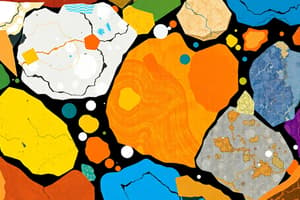Podcast
Questions and Answers
What is a mineral?
What is a mineral?
- A man-made substance
- A naturally occurring element or compound (correct)
- A synthetic compound formed in a lab
- A substance found only in outer space
Which major group of minerals is of interest to environmental geology?
Which major group of minerals is of interest to environmental geology?
- Phosphates
- Halides
- Sulfates
- Silicates (correct)
How are rocks classified based on their formation processes?
How are rocks classified based on their formation processes?
- By hardness
- By color
- By taste
- By how they were formed in the rock cycle (correct)
Which process is intimately related to the rock cycle?
Which process is intimately related to the rock cycle?
Which type of rocks crystallized from magma?
Which type of rocks crystallized from magma?
Which type of rocks are formed from parts of other rocks or by chemical processes?
Which type of rocks are formed from parts of other rocks or by chemical processes?
What factors can change metamorphic rocks?
What factors can change metamorphic rocks?
What properties of minerals and rocks may have environmental importance?
What properties of minerals and rocks may have environmental importance?
What is the main importance of weathering in relation to Earth processes?
What is the main importance of weathering in relation to Earth processes?
What are common rock structures that may have important environmental consequences?
What are common rock structures that may have important environmental consequences?
Flashcards are hidden until you start studying
Study Notes
Definition and Importance of Minerals
- Minerals are naturally occurring, inorganic solids with a definite chemical composition and crystalline structure.
- The major group of minerals that concerns environmental geology is silicates, primarily because they make up the majority of the Earth’s crust and play significant roles in soil formation and nutrient cycling.
Rock Classification
- Rocks are classified into three main types based on their formation processes: igneous, sedimentary, and metamorphic.
- Igneous rocks form through the cooling and solidification of magma or lava.
- Sedimentary rocks are created from the accumulation of sediment, derived from the erosion of other rocks or through chemical processes.
- Metamorphic rocks arise from the alteration of existing rocks due to temperature, pressure, and chemically active fluids.
The Rock Cycle
- The rock cycle describes the continuous processes of rock formation, transformation, and erosion.
- Weathering and erosion are closely related to the rock cycle, enabling the breakdown and transportation of rocks.
Rock Types and Formation
- Igneous rocks crystallized from molten material (magma) as it cools either beneath the Earth’s surface or after volcanic eruptions.
- Sedimentary rocks can form from fragments of other rocks (clastic) or through chemical precipitation (chemical).
Factors Affecting Metamorphic Rocks
- Metamorphic rocks can be altered by temperature, pressure, and the presence of chemically active fluids.
- Original minerals in the rock can change into new minerals as conditions change, a process known as metamorphism.
Environmental Properties of Minerals and Rocks
- Properties of minerals and rocks, such as permeability, porosity, and chemical composition, are important for understanding water movement, soil health, and pollutant transport.
- Specific minerals can also influence the availability of nutrients for ecosystems.
Importance of Weathering
- Weathering plays a crucial role in breaking down rocks and minerals, contributing to soil formation and influencing the landscape.
- It also affects nutrient cycling, making essential elements available for plant growth and supporting various life forms.
Rock Structures and Environmental Consequences
- Common rock structures, including faults, folds, and fractures, can significantly impact natural hazards like landslides and earthquakes.
- Understanding these structures is vital for assessing geological hazards and managing land use effectively.
Studying That Suits You
Use AI to generate personalized quizzes and flashcards to suit your learning preferences.




